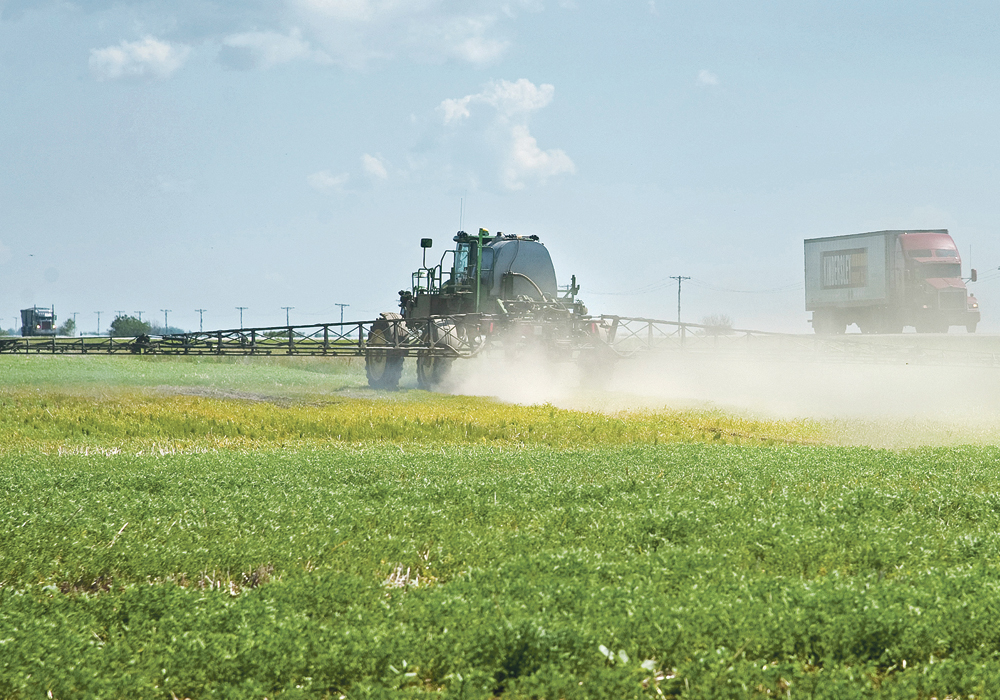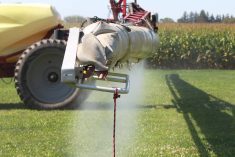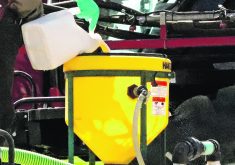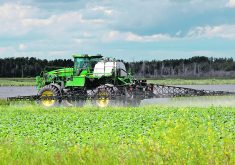Glyphosate, the herbicide that has revolutionized weed control since its introduction in 1974, faces steadily increasing restrictions and in some cases outright bans in various countries around the world.
That situation is putting pressure on farmers to find alternative measures of weed control. Though there is increased emphasis now on developing new modes of action in herbicides, the loss of glyphosate in the weed control arsenal would be a major blow, said weed scientist Hugh Beckie.
Beckie, formerly with Agriculture Canada in Saskatoon, is now director of Australia’s herbicide resistance initiative at the University of Western Australia in Perth.
Read Also

Farming Smarter receives financial boost from Alberta government for potato research
Farming Smarter near Lethbridge got a boost to its research equipment, thanks to the Alberta government’s increase in funding for research associations.
“Yes, we’re seeing a resurgence in herbicide discovery, but it’s still going to be not what it was in the ’50s, ’60s and ’70s, the heydays of the chemical era,” Beckie told those at the December Farming Smarter conference in Lethbridge.
“But also we’re seeing a number of countries that are banning not just glyphosate but products like peraquat, 2,4-D, some fungicides and herbicides, so I expect, for example, in five years the majority of the European Union countries will have banned glyphosate. Peraquat is already banned in many areas.
“In Australia, we’re quite concerned about losing glyphosate. Most growers think we will lose it in the next five years. And it’s not just glyphosate. It could be other herbicides as well.… Certainly in conservation tillage, glyphosate has been the bedrock and so if we lose glyphosate, there would certainly be more mechanical weed control.”
Beckie has long been at the forefront of research into herbicide resistant weeds. Australian farmers have been battling them for years but are able to remain profitable by using an array of management tools, he said.
Among those is the use of “crop topping,” in which peraquat or glyphosate are sprayed pre-harvest to reduce weed seed set and to desiccate the crop.
“Harvest weed seed control, we call that the holy grail of weed management, and that’s really kept a lot of growers in Australia in business when times were tough,” Beckie said.
“In Australia I would guess that 90 percent of growers use some form of harvest weed seed control.”
“The adoption does drop off when you go to New South Wales and Queensland. It’s about 60 percent.”
Harvest weed seed control measures include herbicides, mechanical weed seed destruction, collection of weed seeds via a chaff cart and post-harvest chaff windrow burning, although the latter is becoming less popular because of environmental concerns.
“By 2022 we expect most growers to use some form of harvest weed seed control. If you have livestock, the chaff cart is often the preferred choice when you have sheep,” Beckie said of Australian activity.
Seed destructors are also popular. Agriculture Canada researcher Breanne Tidemann gave an overview of Canadian experience with seed destructors along with data on the rising problem of herbicide resistance weeds in Canada.
Several mechanical seed destructors are available in Canada, though Tidemann said most growers still consider them too expensive.
Beckie noted the same price resistance in Australia, where the first mechanical seed destructor was invented, but said prices are gradually dropping. He put the average cost at AUS$80,000.
“Growers may be wise, maybe, to just wait one or two years and let the dust settle before they jump in because a lot of the early units, they did wear out prematurely or they weren’t engineered the best,” Beckie said.
Though Australia’s efforts to reduce the weed seed bank have been successful, the weeds are wily.
“The weeds are developing ways to evade harvest weed seed control, and we see this most readily with wild radish, where we see more populations that are flowering earlier, that are dropping their pods earlier, before harvest, and normally they don’t do that,” he said.
“After 30 years of harvest weed seed control, you are providing a selection pressure, so we are monitoring for this adaptation. That just shows you that you have to diversify everything in your weed management tool box, not just herbicides.”
However, there are still ways to battle worthy weed adversaries.
Beckie said precision weed management is one route being embraced in Australia. In fallow land, most growers use digital weed seekers that spray only ground where weeds are growing. That has resulted in herbicide cost savings of up to 90 percent.
Precision technology in the form of a “weed chipper” is another control method. Using cameras, machines are directed to simply dig out weeds that are seen.
“If we lose glyphosate, maybe the weed chipper will become more prominent in fallow or inter-row tillage,” said Beckie.
Australian weed researchers are also exploring ways to map weeds in a field. Thirty years of harvest weed seed control have resulted in more patchiness, so those patches can be identified using drones and then addressed.
Light detection and ranging (LIDAR) technology is also being explored to find weeds that rise above the crop canopy at harvest. Wild oats and brome are two examples.
“By detecting these patches, we then develop a prescription map, and then we can just apply not only herbicides but you can apply higher seeding rates or your best herbicide package just to those weed patches,” Beckie said.
Australia and parts of the United States are addressing the herbicide-resistant weed battle by forming regional groups comprising farmers, municipal officials and chemical retailers to address specific problems.
Beckie said Australia has had to revise its previous strategy of “take no prisoners” when it comes to weed control.
Resistance has made that more difficult, and the potential loss of glyphosate as a tool makes it even more unrealistic.
The best strategies now are to use pre-emergent herbicide, plant competitive crops and harvest weed seed control.
Still, the herbicide issue looms large.
“This whole issue of social licence, I think we will lose some herbicides,” said Beckie.
“I hope it’s not glyphosate, but the experts say there’s a 50-50 chance of losing glyphosate. If we lose glyphosate, peraquat for example is so much more toxic than glyphosate. We’re certainly going to lose peraquat as well, so that’s a concern to no-tillage farmers everywhere.”


















